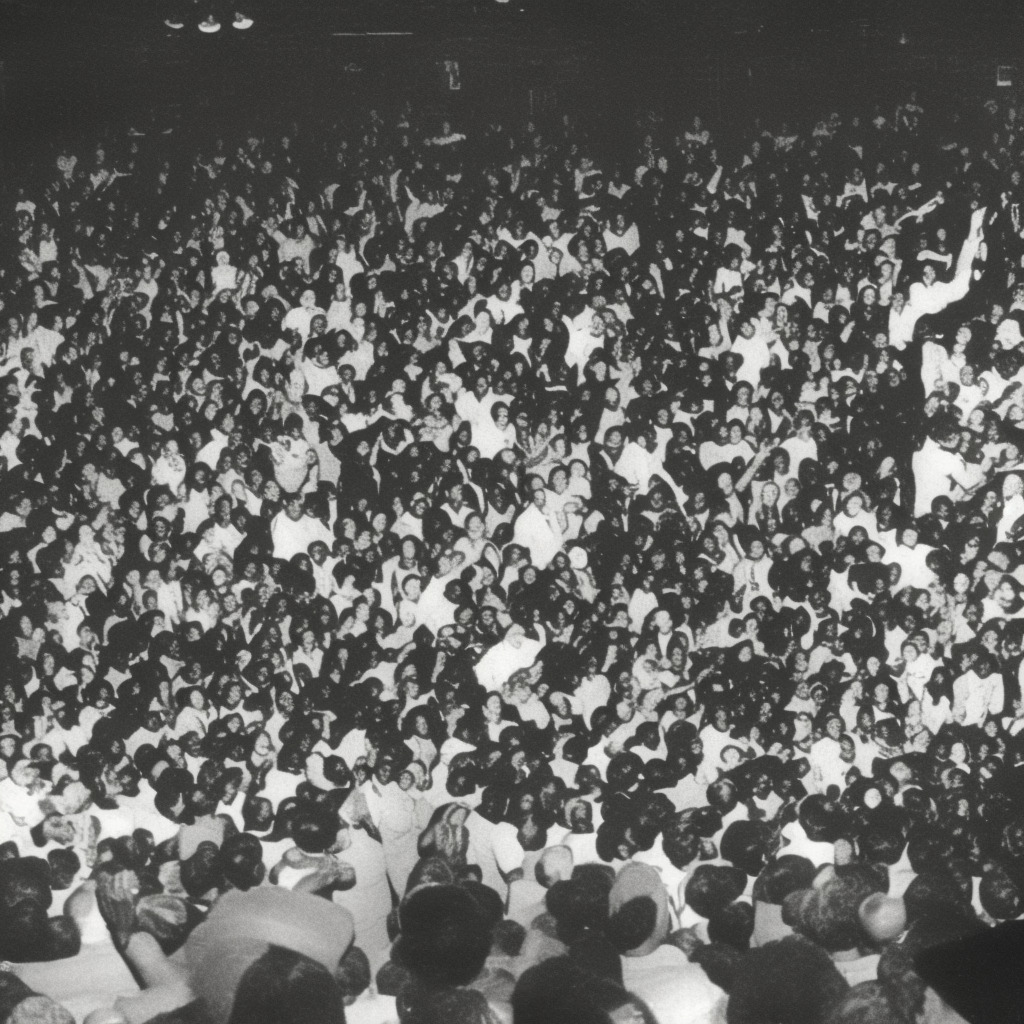Did you know? “The Hand That Feeds” was the 1st NIN track to hit Top 40 Radio! 🎶📈 A catchy industrial bop that feeds our rebellious souls! 🤘😎 #NineInchNails #FunFact #TheHandThatFeeds #NINTrivia Read about it: tinyurl.com/3yux4psy
Feeding on the Edge of an Industrial Revolution
Challenging the status quo with a blend of industrial rock and socio-political commentary, Nine Inch Nails’ “The Hand That Feeds” remains a powerful, provocative anthem in the band’s storied career.

For nearly three decades, Nine Inch Nails has been an anchor in the industrial rock scene, led by the incomparable Trent Reznor. Founded in 1988 in Cleveland, Ohio, Reznor has been the band’s creative force, often acting as the sole official member and enlisting various renowned musicians for studio recordings and live performances.
Nine Inch Nails released their single “The Hand That Feeds” in 2005, from their fourth studio album, “With Teeth.” The song showcases Reznor’s signature blend of dark synth textures, aggressive guitars, and introspective, provocative lyrics. “The Hand That Feeds” is a scathing critique of the establishment and conformity, questioning the listener’s willingness to challenge authority and the consequences of doing so.
The lineup of Nine Inch Nails has varied throughout the years, with Reznor being the only constant member. However, the inclusion of other talented musicians, such as guitarist Robin Finck, keyboardist Alessandro Cortini, and drummer Ilan Rubin, has allowed the band to maintain a high level of musicianship and intrigue.
As for the criticism, some detractors argue that Reznor has often ventured too far into self-indulgence, and although “The Hand That Feeds” addresses important socio-political themes, some listeners might find it heavy-handed or even preachy at times. However, the song still stands as a powerful anthem for questioning and challenging the status quo.
Throughout their illustrious career, Nine Inch Nails have received numerous awards and accolades, solidifying their place in music history. The band has been nominated for 13 Grammy Awards, winning two for Best Metal Performance (“Wish” in 1992) and Best Hard Rock Performance (“Happiness in Slavery” in 1996). Additionally, in 2020, Nine Inch Nails was inducted into the Rock & Roll Hall of Fame, a fitting recognition of Reznor’s lasting impact on the music industry.
In conclusion, while “The Hand That Feeds” may not be immune to criticism, it serves as a prime example of Nine Inch Nails’ innovative approach to blending industrial rock with socio-political commentary, solidifying their status as music legends. As a music blogger, I invite you to revisit this modern classic and share your thoughts in the comments section below.
Charting the Course of Industrial Success
Climbing Global Charts: NIN’s “The Hand That Feeds” solidifies their industrial rock legacy with impressive chart performance and a Grammy nod.

Nine Inch Nails’ iconic track “The Hand That Feeds” made its mark on music charts around the globe, showcasing the enduring popularity of Trent Reznor’s industrial rock sound. Released on March 28, 2005, as the lead single from their fourth studio album, “With Teeth,” this track quickly became a fan favorite and solidified Nine Inch Nails’ position in the industry.
Upon its release, “The Hand That Feeds” entered the Billboard Hot 100 at an impressive #76, peaking at #31 on May 21, 2005. It held this position for a week, proving to be one of the band’s most successful singles on the chart. The song also found its way onto other Billboard charts – it climbed to the top spot on the Modern Rock Tracks chart and remained there for five consecutive weeks. Additionally, it secured the #2 position on the Mainstream Rock Tracks chart.
“The Hand That Feeds” fared well internationally as well, landing at #7 on the UK Singles Chart, making it the band’s highest-charting single in the UK at the time. The track also made an appearance on the Australian Singles Chart, peaking at #34, and the Irish Singles Chart, where it reached #31.
This track’s performance on various charts is a testament to its widespread appeal and the magnetic pull of Nine Inch Nails’ signature sound. A notable achievement worth mentioning is the 2006 Grammy Awards nomination for Best Hard Rock Performance. Though the award ultimately went to System of a Down, the nomination itself speaks volumes about the song’s impact in the music world.
In conclusion, “The Hand That Feeds” has undeniably left an indelible mark on the music industry, solidifying Nine Inch Nails’ reputation as a force to be reckoned with. The song’s chart success serves as a testament to the band’s ability to captivate audiences with their distinctive style and sound.
Dissecting the Powerful Lyrics
In the line
Got your chin held high and you feel just fine
Because you do
What you’re told
But inside your heart it is black and it’s hollow and it’s cold
Just how deep do you believe?
Will you bite the hand that feeds?
Will you chew until it bleeds?
Can you get up off your knees?
Are you brave enough to see?
Do you want to change it?
What if this whole crusade’s
A charade
And behind it all there’s a price to be paid
For the blood
On which we dine
Justified in the name of the holy and the divine
Just how deep do you believe?
Will you bite the hand that feeds?
Will you chew until it bleeds?
Can you get up off your knees?
Are you brave enough to see?
Do you want to change it?
So naïve
I keep holding on to what I want to believe
I can see
But I keep holding on and on and on and on
Will you bite the hand that feeds you?
Will you stay down on your knees?
Will you bite the hand that feeds you?
Will you stay down on your knees?
“The Hand That Feeds” by Nine Inch Nails comes packed with lyrics that evoke a sense of rebellion and a call to question authority. Released in 2005, the song perfectly captures the spirit of the time as the world dealt with the aftermath of the 9/11 attacks, wars in Iraq and Afghanistan, and a political climate fraught with fear and distrust.
The lyrics speak to a growing sense of disillusionment in society, as people start to question the very institutions and powers that they had once blindly followed. Lines like “You’re keeping in step / In the line / Got your chin held high and you feel just fine / Because you do / What you’re told” paint a picture of the masses marching in lockstep with the status quo, while “But inside your heart it is black and it’s hollow and it’s cold” gives voice to the dissatisfaction and emptiness that many people were starting to feel.
The song then poses a series of powerful questions, such as “Will you bite the hand that feeds?” and “Are you brave enough to see?”, urging the listener to examine their own beliefs and willingness to challenge the powers that be. This introspection very much mirrors the era in which the song was written, as individuals and society as a whole grappled with a loss of innocence and the realization that the institutions they had previously looked to for guidance and protection were not infallible.
In the midst of this shifting landscape, “The Hand That Feeds” stands as a potent reminder of the importance of questioning authority and standing up for what is right, even when it means challenging those who hold power over us. The song’s message remains relevant to this day, as the world continues to navigate the complexities of politics, power, and the search for truth.
A Closer Look at the “The Hand That Feeds” Music Video
Unleashing raw energy and artistic simplicity, “The Hand That Feeds” video captivates with its gritty, industrial aesthetics and enduring impact on the Nine Inch Nails fandom.
“The Hand That Feeds” music video, directed by Rob Sheridan, perfectly encapsulates the energy and intensity of Nine Inch Nails. Sheridan, who has collaborated with the band for years as their art director, demonstrates a deep understanding of the band’s aesthetic and messaging. The video was released in 2005 and quickly became a fan favorite, thanks to its raw simplicity and powerful visuals.
Shot entirely in black and white, the video features the band performing the song in their rehearsal space. The decision to film in black and white adds a gritty, industrial feel to the video, enhancing the song’s aggressive lyrics and tone. Sheridan’s decision to use a single-camera setup, with quick cuts and shaky camera movements, creates an intimate and visceral atmosphere, placing the viewer right in the middle of the band’s explosive performance.
The video’s production details are quite fascinating, as it was created on a modest budget. In fact, most of the equipment and props seen in the video were borrowed or rented, including the lights and projectors. Despite its limited resources, the video manages to make a significant impact, proving that a powerful message can be conveyed without an extravagant production.
One of the most memorable aspects of “The Hand That Feeds” is the video’s striking use of visual effects. The band members are often seen as silhouettes against a pulsating, static-filled backdrop, which adds an extra layer of intensity to their performance. These effects, combined with the frenetic editing and energetic performances, make the video a true feast for the senses.
In the years since its release, the “The Hand That Feeds” music video has inspired numerous fan tributes and covers on YouTube. Fans have also created their own versions of the video, using alternate footage or experimenting with different editing techniques. These tributes serve as a testament to the enduring impact of the song and the creative vision of Nine Inch Nails and Rob Sheridan.
In conclusion, the music video for “The Hand That Feeds” offers a perfect blend of powerful visuals, raw energy, and artistic simplicity. Its lasting influence on fans and the music world alike is a testament to the incredible work of Nine Inch Nails and their creative collaborators.
A Deep Dive into the Mastermind Behind “The Hand That Feeds”
Trent Reznor, the creative genius and driving force behind Nine Inch Nails, is the composer of the iconic track “The Hand That Feeds.” Born on May 17, 1965, in New Castle, Pennsylvania, Reznor has been a key figure in the alternative and industrial rock scene since the late 1980s. Apart from his work with Nine Inch Nails, Reznor has also collaborated with various artists and produced successful film scores, such as his Academy Award-winning work on “The Social Network” and “The Girl with the Dragon Tattoo.”
One of Reznor’s many notable compositions is the song “Hurt,” released in 1994 on the critically acclaimed album “The Downward Spiral.” This song gained further recognition when it was famously covered by the legendary Johnny Cash in 2002. Reznor’s unique blend of industrial sounds, dark lyrics, and innovative electronic elements has earned him a solid place in the world of music, and his compositions continue to resonate with fans across generations.
A Legacy of Recognition and Influence
Influential Anthem: Nine Inch Nails’ “The Hand That Feeds” dominates charts, permeates pop culture, and inspires artistic reinterpretations since 2005.

“The Hand That Feeds” has undoubtedly left a mark in the world of music since its release in 2005. This song, which serves as the lead single from their fourth studio album, “With Teeth,” has garnered several accolades and recognitions. The track quickly climbed the charts, peaking at the second position on the Billboard Modern Rock Tracks chart and number 31 on the Billboard Hot 100, making it one of the most successful songs in Nine Inch Nails’ career. In 2006, the song received a Grammy nomination for Best Hard Rock Performance, further showcasing its impact on the music industry.
Not limited to the world of music, “The Hand That Feeds” has found its way into popular culture through various media appearances. For instance, the song was featured in the 2005 film “Doom,” starring Dwayne “The Rock” Johnson, and the 2006 film “The Sentinel,” starring Kiefer Sutherland and Michael Douglas. Additionally, the song has been used in several video games, including “Guitar Hero: Warriors of Rock” and “Rock Band,” allowing players to experience the thrill of performing the intense track.
Over the years, “The Hand That Feeds” has inspired numerous artists to produce their cover versions of this iconic song. One notable example is the rendition by the indie-rock band The Fray, who transformed the original’s aggressive sound into a stripped-down, piano-driven ballad. Additionally, in 2016, electronic rock band Julien-K released their dark and atmospheric rendition of the song on their “California Noir, Chapter 2” album. These covers not only pay tribute to the original but also showcase the versatility and influence of “The Hand That Feeds” on the music scene.
In summary, “The Hand That Feeds” has undoubtedly secured its place in music history through its achievements, media appearances, and the lasting impact it has had on both listeners and fellow artists. Nine Inch Nails has created a song that transcends its original genre and continues to be celebrated and admired more than a decade after its release.
Deconstructing the Musicality
Diving into the musical structure of “The Hand That Feeds,” we find that the song is written in the key of D minor, which sets the tone for its dark and industrial atmosphere. The song follows a fairly consistent D minor chord progression throughout its verses and choruses, with the occasional shift to other chords like A major and B♭ major to add tension and depth.
One of the most striking aspects of the song is its tempo, which clocks in at a driving 128 beats per minute (BPM). This tempo, coupled with the syncopated rhythm of the drums and the pulsating bassline, creates a relentless energy that propels the listener through the song’s various sections. The layering of the drums, synths, and guitars also contributes to the overall sonic density, which is a hallmark of Nine Inch Nails’ style.
As for the melody, Trent Reznor’s vocals follow a repetitive and hypnotic pattern that mirrors the relentless beat. The verse melody revolves around the root note of D, while the chorus melody takes a more dynamic approach, climbing up and down the D minor scale. This contrast between the static verse and the dynamic chorus creates a sense of tension and release that keeps the listener engaged.
The arrangement of “The Hand That Feeds” is also worth exploring. The song begins with a simple drum beat, gradually introducing the other instruments one by one. The bassline enters first, followed by the guitars, and finally, the synths. This layering creates a sense of anticipation and buildup that leads seamlessly into the first verse. Throughout the song, the different instruments weave in and out of the mix, giving each part of the arrangement its own unique texture and character.
Perhaps the most iconic element of the song’s production is the use of distortion and audio manipulation. The guitars, synths, and even Reznor’s vocals are heavily processed, creating a gritty and aggressive sound that is synonymous with Nine Inch Nails’ aesthetic. This distortion serves to reinforce the song’s themes of control, defiance, and resistance.
In conclusion, the success of “The Hand That Feeds” can be attributed to its powerful combination of driving tempo, dark and moody chord progressions, and innovative production techniques. These elements come together to create a track that is at once aggressive and entrancing, making it a standout hit in Nine Inch Nails’ illustrious discography.







